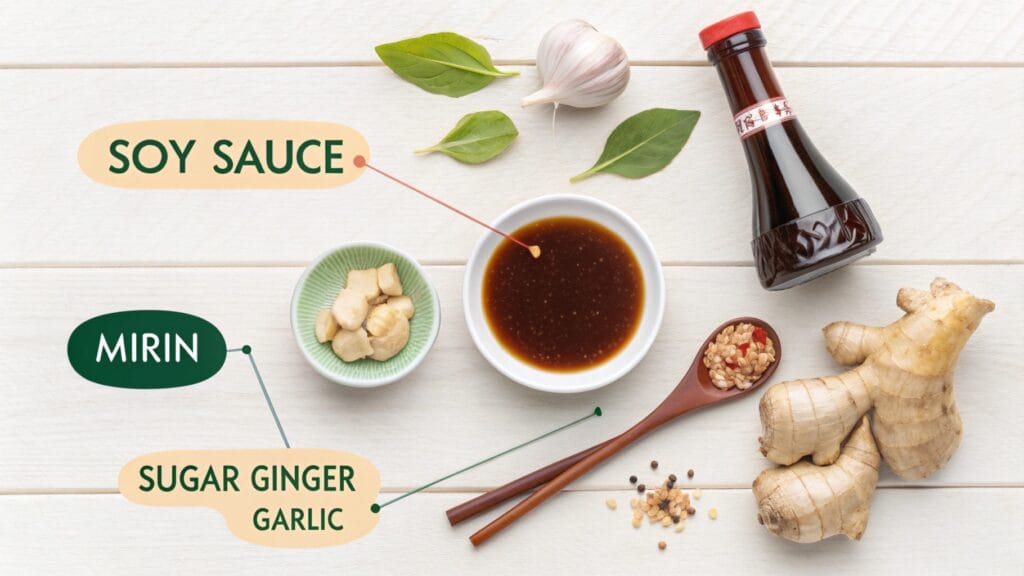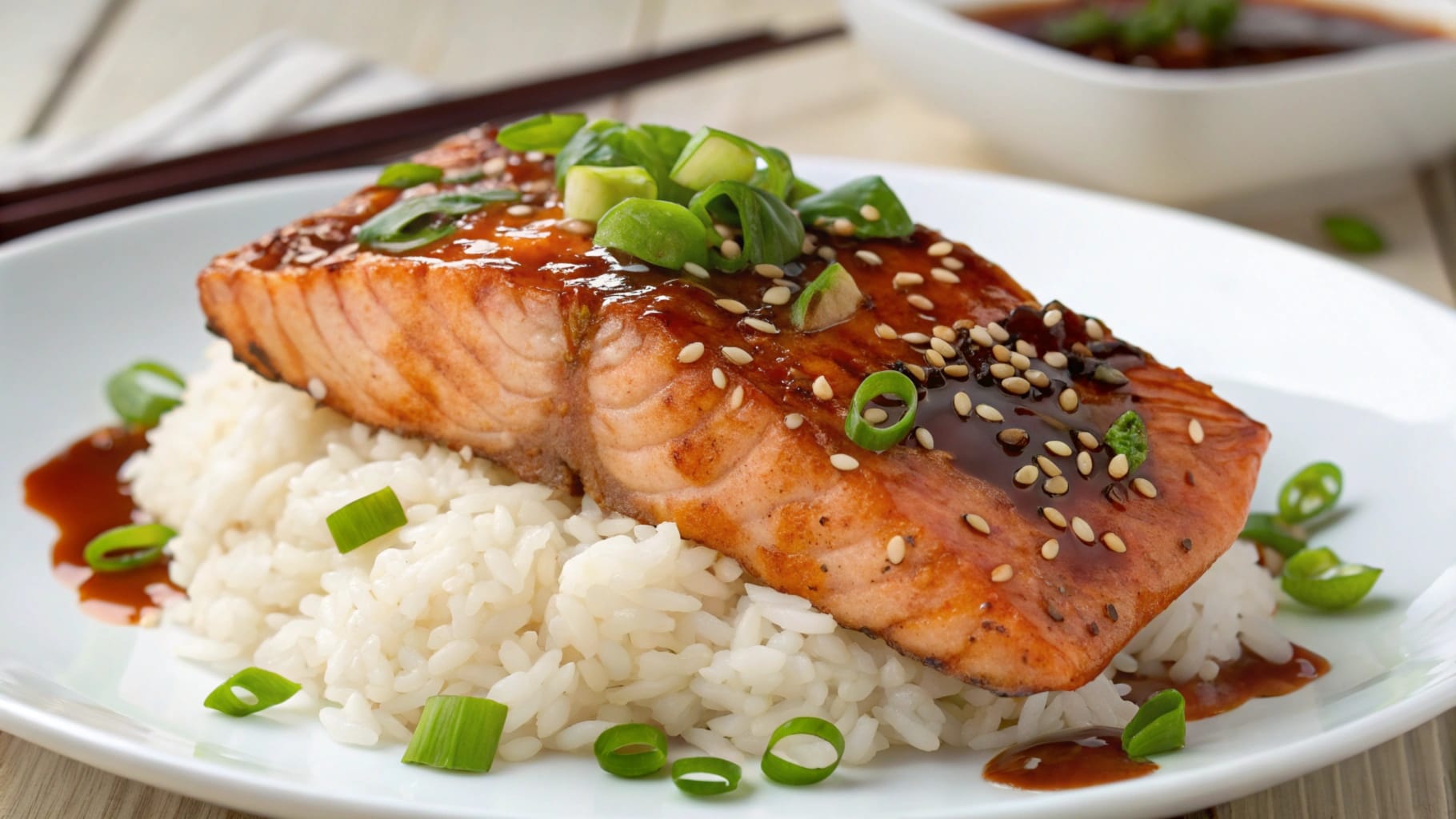Welcome to the ultimate guide that’s all about two amazing things: salmon and teriyaki. If you’re a fan of rich, flavorful dishes or simply want to try something new, this is your go-to resource! We’ll dive deep into everything about this delicious duo, from their origins to tips for cooking them like a pro. Let’s get started! 🎣🍱
Introduction to Salmon and Teriyaki
Salmon and teriyaki are a match made in foodie heaven. Salmon is known for its tender texture and rich, buttery flavor, while teriyaki sauce brings a sweet and savory kick. Together, they create a dish that’s not only mouthwatering but also packed with nutrients. But what makes them so special?
What Makes Salmon and Teriyaki a Perfect Pair?
The magic lies in the balance of flavors. Salmon is naturally rich and slightly oily, making it the perfect canvas for the bold flavors of teriyaki sauce. The sauce, with its sweet, salty, and umami notes, clings to the salmon beautifully, creating a caramelized glaze that’s irresistible. It’s a culinary harmony that’s hard to beat.
Nutritional Benefits of Salmon
You’ve probably heard that salmon is good for you, but do you know why? Let’s break it down.
Essential Nutrients in Salmon
Salmon is a powerhouse of nutrients! Here’s a quick look at what you’re getting in every bite:
| Nutrient | Benefits |
|---|---|
| Omega-3 Fatty Acids | Supports heart health and brain function. |
| Protein | Builds and repairs muscles. |
| Vitamin D | Strengthens bones and boosts immunity. |
| Selenium | Protects cells and supports thyroid function. |
With all this goodness, salmon isn’t just tasty—it’s a health hero. 🦸♂️
Why Salmon is a Superfood
Ever wonder why salmon is called a “superfood”? It’s because it delivers maximum nutrition with minimal calories. Plus, it’s incredibly versatile, fitting into almost any diet—whether you’re into keto, paleo, or just eating clean.
“Let food be thy medicine and medicine be thy food.” – Hippocrates
Teriyaki: A Flavorful Japanese Classic
Now let’s shine the spotlight on teriyaki. This iconic sauce has been around for centuries and has made its way from Japanese kitchens to dining tables worldwide.
Origin and History of Teriyaki Sauce
Teriyaki originated in Japan, where “teri” means “shine” and “yaki” means “grill.” Traditionally, it’s used as a glaze for grilled or broiled fish and meats. The sauce gets its signature shine from the sugar, mirin (sweet rice wine), and soy sauce blend. Over time, variations have emerged, but the original recipe remains a favorite.

Key Ingredients of Authentic Teriyaki Sauce
Want to make authentic teriyaki sauce? Here’s what you need:
| Ingredient | Quantity |
|---|---|
| Soy Sauce | 1/2 cup |
| Mirin (or rice wine) | 1/4 cup |
| Brown Sugar | 2 tbsp |
| Ginger (grated) | 1 tsp |
| Garlic (minced) | 1 clove |
Mix these together, and you’ve got yourself a homemade teriyaki sauce that’s bursting with flavor. 🍯
Preparing Salmon for Cooking
Before we dive into cooking, let’s talk prep. Getting the salmon ready is half the battle!
Choosing the Freshest Salmon
When buying salmon, always look for bright, firm flesh and a clean, ocean-like smell. If it smells overly fishy or has dull skin, it’s a no-go.
Cleaning and Slicing Tips
If you’ve got a whole fish, remove the scales and rinse it under cold water. Use a sharp knife to slice it into fillets—around 1-inch thick is ideal for even cooking. Pro tip: Pat the salmon dry with a paper towel for better caramelization.
Making the Perfect Teriyaki Sauce
No dish is complete without the right sauce, and teriyaki is no exception. Let’s whip it up!
Traditional Teriyaki Sauce Recipe
Here’s a quick recipe for traditional teriyaki sauce:
- Combine soy sauce, mirin, and brown sugar in a saucepan.
- Add grated ginger and minced garlic for extra depth.
- Simmer on low heat until slightly thickened. Voilà!
Quick and Easy Homemade Teriyaki Sauce
Short on time? Substitute mirin with honey or apple cider vinegar for a quick fix. It’s not entirely traditional, but it’s just as tasty! 🍋
Best Cooking Methods for Salmon and Teriyaki
Finally, it’s time to cook! Here are three foolproof methods to make salmon and teriyaki shine.
Grilling Salmon with Teriyaki Glaze
Grill the salmon over medium heat, brushing it with teriyaki sauce every few minutes. The heat caramelizes the sauce, creating a smoky, sticky glaze.
Pan-Seared Salmon with Teriyaki Drizzle
Heat some oil in a skillet and sear the salmon skin-side down. Once crispy, flip it over and pour in the teriyaki sauce. Let it bubble and coat the fish.
Baking Salmon in Teriyaki Marinade
Marinate the salmon in teriyaki sauce for 30 minutes, then bake at 375°F for 20 minutes. The result? Tender, flavorful fish that’s oh-so satisfying.
The Ultimate Guide to Salmon and Teriyaki (Continued)
Common Problems When Cooking Salmon and Teriyaki
Cooking salmon and teriyaki isn’t always smooth sailing. Let’s tackle the most common problems you might face and how to fix them.
Overcooked or Dry Salmon
Dry salmon is the ultimate buzzkill, right? Overcooking can make this delicate fish lose its juiciness. The key is to cook it just until it flakes easily with a fork. For reference:
- Internal Temperature: Aim for 125°F to 130°F for medium.
- Cooking Time: About 4-6 minutes per side, depending on the thickness.
Too Sweet or Salty Teriyaki Sauce
Ever tasted teriyaki sauce that’s more sugar bomb than savory delight? It’s a common issue, especially with store-bought versions. The fix? Balance it out by adding a splash of rice vinegar or lemon juice to cut through the sweetness.
Preventing Sticking During Cooking
There’s nothing worse than your salmon sticking to the pan or grill. To avoid this:
- Heat your pan or grill before adding the fish.
- Brush the surface with oil.
- Use a spatula to carefully flip the salmon.
Solutions to Cooking Challenges
Now that we’ve identified the problems, let’s dive into actionable solutions to elevate your salmon and teriyaki game. 🎯
How to Keep Salmon Moist
Moist salmon starts with preparation. Marinate your salmon in a mix of teriyaki sauce and olive oil for at least 30 minutes. This helps lock in moisture while adding flavor. Wrapping the fish in foil while baking is another great hack to keep it juicy.
Balancing Flavors in Teriyaki Sauce
For homemade teriyaki, always taste-test! If it’s too sweet, add salt or soy sauce. Too salty? Add sugar or honey. And if it’s too thick, thin it out with water or stock.
“Cooking is like painting; a dash of this and a splash of that create a masterpiece!”
Properly Oiling the Cooking Surface
Think of oiling your pan like seasoning a cast-iron skillet. Use a high-smoke-point oil (like vegetable or canola) and coat the surface lightly but evenly.
Pairing Salmon and Teriyaki with Sides
No dish is complete without some tasty sides. Pair your salmon and teriyaki with these simple yet delicious options.
Rice and Noodle Dishes
Nothing beats fluffy white rice or savory noodles alongside salmon and teriyaki. Here are a few ideas:
- Steamed Jasmine Rice: Absorbs the teriyaki sauce like a sponge. 🍚
- Fried Rice: Add veggies, eggs, and a dash of soy sauce for extra flavor.
- Soba Noodles: Toss them with sesame oil and soy sauce for a light side.
Vegetables and Salads
Balance the richness of the salmon with fresh veggies or salads. Try:
- Steamed Broccoli: Add a sprinkle of sesame seeds for crunch.
- Cucumber Salad: Toss thinly sliced cucumbers in rice vinegar and sugar.
- Roasted Asparagus: Drizzle with olive oil and lemon juice.
Creative Variations of Salmon and Teriyaki
Want to take things up a notch? Here are some fun and creative ways to enjoy salmon and teriyaki.
Spicy Teriyaki Salmon
Kick things up a gear by adding chili flakes or Sriracha to your teriyaki sauce. It’s the perfect balance of sweet and heat. 🌶️
Teriyaki Salmon Sushi Rolls
Turn your salmon into sushi! Roll slices of cooked teriyaki salmon with sushi rice, nori, and avocado. Serve with soy sauce and wasabi for a restaurant-style experience.
Teriyaki Salmon Burgers
Use minced salmon mixed with breadcrumbs, green onions, and teriyaki sauce to create flavorful burger patties. Grill and serve on a bun with a drizzle of extra teriyaki. 🍔
Storing and Reheating Tips
If you have leftovers (lucky you!), proper storage is key.
Best Practices for Storing Cooked Salmon
- Refrigeration: Store cooked salmon in an airtight container for up to 3 days.
- Freezing: Wrap tightly in foil and freeze for up to 2 months.
Reheating Without Losing Flavor
To reheat salmon without drying it out, place it in a pan with a splash of water or broth. Cover with a lid and warm over low heat.
Health Considerations and Allergen Warnings
Salmon and teriyaki are generally healthy, but there are a few things to watch out for.
Soy Sauce Alternatives for Teriyaki
If you’re sensitive to soy or gluten, opt for tamari or coconut aminos as a soy sauce substitute. Both provide the same savory flavor without allergens.
Mercury Levels in Salmon
While salmon is low in mercury compared to other fish, it’s still good to moderate your intake, especially for kids and pregnant women.
Conclusion: Why Salmon and Teriyaki are Worth Trying
Salmon and teriyaki aren’t just a meal—they’re an experience. From their health benefits to their incredible taste, they truly check all the boxes. So, what are you waiting for? Get cooking and let your taste buds thank you. 🍴
“Food is not just eating energy. It’s an experience.”
FAQ: Salmon and Teriyaki
1. What is the best way to cook salmon with teriyaki sauce?
The best way to cook salmon with teriyaki sauce depends on your preferred texture and flavor. Here are three popular methods:
- Grilling: Gives a smoky flavor and caramelizes the teriyaki glaze beautifully. Brush the sauce on while grilling for maximum flavor.
- Pan-Searing: Ideal for a crispy salmon skin. Add teriyaki sauce toward the end to prevent burning.
- Baking: Marinate the salmon in teriyaki sauce and bake it for even cooking and a tender, juicy texture.
Each method creates a delicious dish; it just depends on your mood and cooking style!
2. Can I make teriyaki sauce without soy sauce?
Yes! If you’re avoiding soy, try these substitutes for a similar savory flavor:
- Tamari: A gluten-free option that tastes almost identical to soy sauce.
- Coconut Aminos: A slightly sweeter, soy-free alternative.
- Homemade Substitute: Mix balsamic vinegar, Worcestershire sauce, and a touch of honey.
These alternatives ensure you still enjoy a flavorful teriyaki sauce without soy.
3. How do I keep salmon from sticking to the pan or grill?
Salmon sticking to the pan or grill is a common issue, but here’s how to avoid it:
- Preheat the Pan/Grill: A hot surface helps form a crust that prevents sticking.
- Oil It Well: Brush the pan, grill grates, or salmon skin with a high-smoke-point oil like vegetable or avocado oil.
- Don’t Flip Too Soon: Let the salmon cook until it naturally releases from the surface. Rushing can cause sticking.
Following these tips ensures your salmon stays intact and beautifully cooked.
4. What sides go best with salmon and teriyaki?
The best sides balance the rich flavors of salmon and teriyaki. Popular choices include:
- Steamed Jasmine Rice: Soaks up the teriyaki sauce perfectly.
- Vegetable Stir-Fry: Adds crunch and nutrients with broccoli, carrots, and snap peas.
- Asian-Inspired Salads: Toss cucumbers, radishes, and sesame seeds in a light dressing.
Feel free to experiment with your favorite grains and veggies to create the perfect pairing.
5. Is teriyaki salmon healthy?
Yes, teriyaki salmon is a healthy option, as long as you manage the sugar and sodium in the teriyaki sauce. Here’s why:
- Salmon Benefits: High in omega-3 fatty acids, protein, and vitamins, salmon supports heart and brain health.
- Homemade Sauce: By making your teriyaki sauce, you can reduce sugar and salt for a healthier dish.
- Balanced Meal: Pair with whole grains and fresh vegetables for a well-rounded, nutritious meal.
When prepared thoughtfully, teriyaki salmon is a delicious and healthy choice for any diet! 🍣✨

